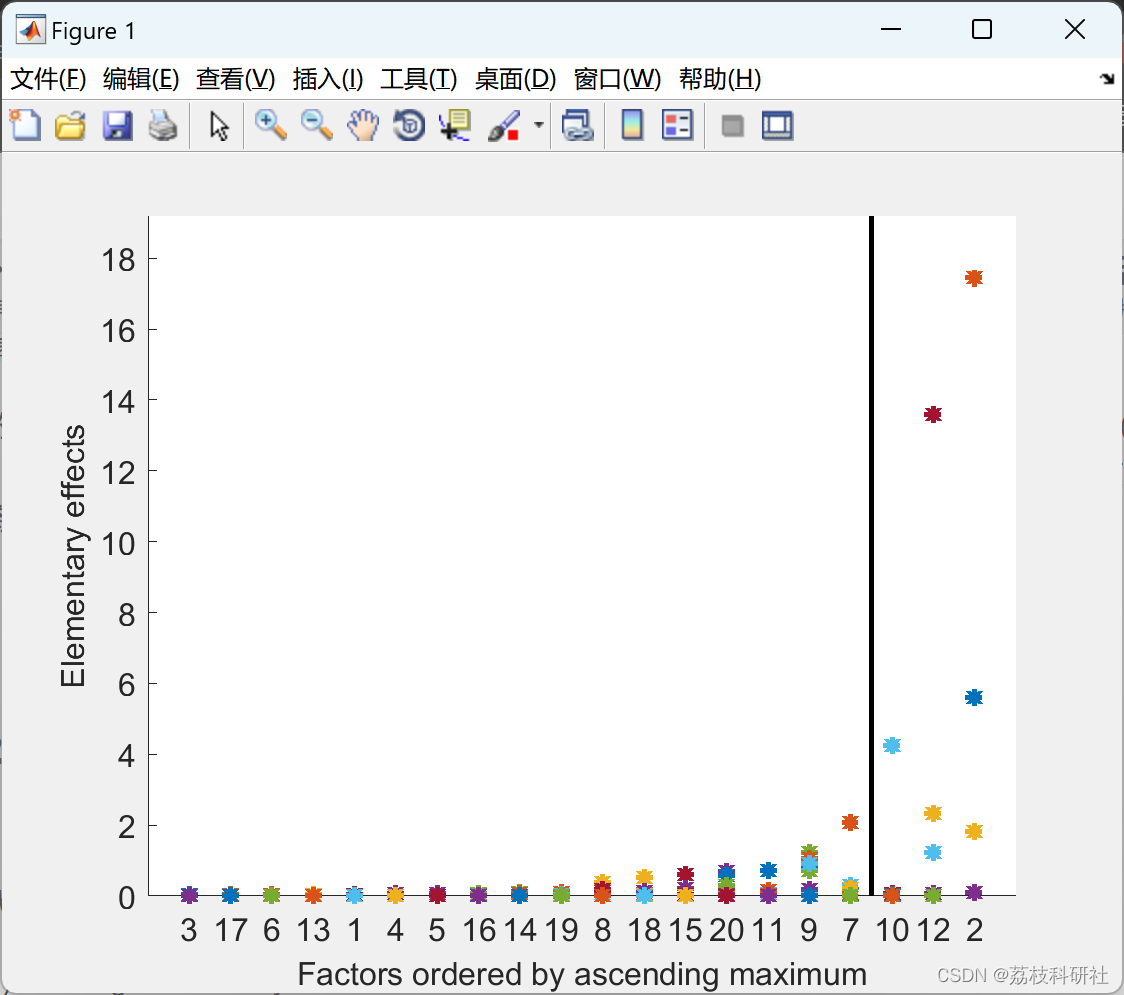👨🎓个人主页:研学社的博客
💥💥💞💞欢迎来到本博客❤️❤️💥💥
🏆博主优势:🌞🌞🌞博客内容尽量做到思维缜密,逻辑清晰,为了方便读者。
⛳️座右铭:行百里者,半于九十。
📋📋📋本文目录如下:🎁🎁🎁
目录
💥1 概述
灵敏度分析用于估计不确定性因素对函数输出的影响。莫里斯方法有时被称为定性方法:它给出有限数量的计算的粗略估计。作为第一步,莫里斯方法可用于简化函数。它可以识别可以固定的低影响因素。
分析的函数必须是具有一个多维输入 x 的函数,x 必须表示分位数超空间中不确定性因子的值(x 的第 i 个坐标不是第 i 个因子的实际值,而是其累积分布函数的相应值)。要调整您的函数,首先通过将因子的累积分布函数的反函数应用于 x 来计算因子的实际值.
📚2 运行结果

部分代码:
%% 1) Clearing the memory
close all; % Closes the figures
clear all; % Clears the memory
clc; % Clears the command window
%% 2) Parameters : Please fill in
% Number of factors of uncertainty of the function studied :
nfac=20;
% Maximum number of simulation runs :
% Large number = better estimation of the influence of the factors
% Recommended value : (number of factors + 1) * 10
% The algorithm will maybe exceed this value if it is considered necessary
nsim_max = 210;
% Function studied :
% Replace test_function by the name of your function. It must be a
% function with one multidimensional input x. x must represent the values
% of the uncertainty factors in the quantiles hyperspace (the i-th
% coordinate of x is not the actual value of the i-th factor, but the
% corresponding value of the cumulative distribution function of the i-th
% factor). To adapt your function, first calculate the actual values of
% the factors by applying the inverse of their cumulative distribution
% function to each coordinate of x; Matlab includes such inverses:
% mathworks.com/help/stats/icdf.html ).
studied_function = @(x)test_function(x);
%% 3) Initialization of the variables
table_outputs = []; % All the outputs of the simulations runs. One line = results around one point of the factors hyperspace. First column = output at a sampled point, second column = output after varying the first factor, etc...
table_ee = []; % All the elementary effects. One line = elementary effects at one point of the factors hyperspace. First column = elementary effect of the first factor, etc... See the relation between the outputs of the simulation run and the elementary effects.
factors_over = []; % Indexes of the factors over the limit (important factors). The elementary effects of these factors will not be calculated at the next step.
table_factors_over = []; % Factors over the limit at the different steps. n-th line = factors with no elementary effect at the n-th step = factors over the limit at the (n-1)-th step.
points=[]; % Sampled points of the factors hyperspace where the elementary effects are calculated.
n=1; % Current step.
🎉3 参考文献
部分理论来源于网络,如有侵权请联系删除。
[1]阚丽娟,徐吉辉,陈玉金,宋晓博.安全性要求下系统失效概率及其灵敏度分析[J].安全与环境学报,2022,22(05):2342-2351.DOI:10.13637/j.issn.1009-6094.2021.0650.
[2]Saltelli, A., Tarantola, S., Campolongo, F., and Ratto, M. (2004). Sensitivity Analysis in Practice - A Guide to Assessing Scientific Models. Wiley.
























 517
517











 被折叠的 条评论
为什么被折叠?
被折叠的 条评论
为什么被折叠?










